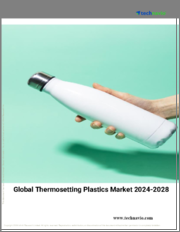
|
시장보고서
상품코드
1755497
열경화성 플라스틱 시장 규모, 점유율, 성장 분석, 유형별, 제조 공정별, 최종 이용 산업별, 지역별 - 산업 예측(2025-2032년)Thermosetting Plastics Market Size, Share, and Growth Analysis, By Type (Epoxy Resins, Phenolic Resins), By Manufacturing Process (Compression Molding, Injection Molding), By End Use Industry, By Region - Industry Forecast 2025-2032 |
||||||
열경화성 플라스틱 세계 시장 규모는 2023년에 168억 2,000만 달러, 2024년 176억 8,000만 달러에서 2032년에는 263억 2,000만 달러로 성장하고, 예측 기간(2025-2032년) CAGR은 5.1%를 나타낼 전망입니다.
세계적으로 저연비, 친환경 자동차로의 전환은 특히 운송 및 항공우주 분야에서 열경화성 수지에 대한 수요를 크게 증가시키고 있습니다. 이들 산업은 경량화 및 고강도 소재를 우선적으로 사용하여 무게와 배출가스를 최소화하면서 성능을 향상시키고 있습니다. 에폭시 및 페놀 수지와 같은 열경화성 플라스틱은 우수한 강도 대 중량비, 내열성 및 치수 안정성을 제공하여 기존 금속을 대체할 수 있는 이상적인 소재입니다. 열경화성 수지의 통합은 특히 전기자동차 및 경량 항공기의 보급에 따라 연료 효율을 높이고 탄소 배출량을 줄이는 데 도움이 됩니다. 또한 열경화성 수지의 열, 화학물질 및 부식 환경에 대한 탁월한 내성은 전자 및 산업 장비와 같은 까다로운 응용 분야에서 신뢰성을 보장하며, 진화하는 시장에서 프리미엄 고성능 소재로서의 입지를 강화합니다.
목차
서론
- 조사 목적
- 조사 범위
- 정의
조사 방법
- 정보 조달
- 2차와 1차 데이터 방법
- 시장 규모 예측
- 시장 전제조건과 제한
주요 요약
- 세계 시장 전망
- 공급과 수요 동향 분석
- 부문별 기회 분석
시장 역학과 전망
- 시장 개요
- 시장 규모
- 시장 역학
- 성장 촉진요인과 기회
- 성장 억제요인과 과제
- Porter의 Five Forces 분석
주요 시장 인사이트
- 중요 성공 요인
- 경쟁 정도
- 주요 투자 기회
- 시장 생태계
- 시장의 매력 지수(2024년)
- PESTEL 분석
- 거시경제 지표
- 밸류체인 분석
- 가격 분석
- 규제 상황
- 사례 연구
- 기술 분석
열경화성 플라스틱 시장 규모 : 유형별&CAGR(2025-2032)
- 시장 개요
- 에폭시 수지
- 페놀 수지
- 폴리우레탄
- 불포화 폴리에스테르수지
- 아미노 수지
- 비닐에스테르 수지
열경화성 플라스틱 시장 규모 : 제조 공정별&CAGR(2025-2032)
- 시장 개요
- 압축 성형
- 사출 성형
- Pultrusion
- 압출
- 스핀 캐스팅
- 반응 사출성형
열경화성 플라스틱 시장 규모 : 최종 이용 산업별&CAGR(2025-2032)
- 시장 개요
- 자동차
- 건설
- 전자기기 및 가전제품
- 항공우주
- 접착제 및 실란트
- 기타
열경화성 플라스틱 시장 규모 : 지역별&CAGR(2025-2032)
- 북미
- 미국
- 캐나다
- 유럽
- 독일
- 스페인
- 프랑스
- 영국
- 이탈리아
- 기타 유럽
- 아시아태평양
- 중국
- 인도
- 일본
- 한국
- 기타 아시아태평양
- 라틴아메리카
- 브라질
- 기타 라틴아메리카
- 중동 및 아프리카
- GCC 국가
- 남아프리카공화국
- 기타 중동 및 아프리카
경쟁 정보
- 주요 5개사 비교
- 주요 기업의 시장 포지셔닝(2024년)
- 주요 시장 기업이 채택한 전략
- 최근 시장 동향
- 기업의 시장 점유율 분석(2024년)
- 주요 기업 개요
- 기업 상세
- 제품 포트폴리오 분석
- 기업 부문별 점유율 분석
- 매출 전년대비 비교(2022-2024년)
주요 기업 개요
- LANXESS AG(Germany)
- DAICEL Corporation(Japan)
- BASF SE(Germany)
- Alchemie Ltd(U.K.)
- Asahi Kasei Corporation(Japan)
- BUFA GmbH & Co. KG(Germany)
- DSM(Netherlands)
- Eastman Chemical Company(U.S.)
- Kanoria Chembond Pvt. Ltd.(India)
- LG Chem(South Korea)
- Mitsubishi Engineering-Plastics Corporation(Japan)
- NIHON GOSEI KAKO Co., Ltd.(Japan)
- Polynt S.p.A.(Italy)
- Resonac Holdings Corporation(Japan)
- Sumitomo Bakelite Co., Ltd.(Japan)
- U-PICA Company Ltd.(Japan)
- Westlake Corporation(U.S.)
결론과 제안
LSH 25.07.01Global Thermosetting Plastics Market size was valued at USD 16.82 billion in 2023 and is poised to grow from USD 17.68 billion in 2024 to USD 26.32 billion by 2032, growing at a CAGR of 5.1% during the forecast period (2025-2032).
The global shift towards fuel-efficient and eco-friendly vehicles is significantly boosting the demand for thermosets, particularly in the transportation and aerospace sectors. These industries prioritize lightweight yet high-strength materials, which enhance performance while minimizing weight and emissions. Thermosetting plastics, such as epoxy and phenolic resins, offer superior strength-to-weight ratios, thermal resistance, and dimensional stability, making them ideal alternatives to traditional metals. Their integration supports improved fuel efficiency and reduced carbon footprints, especially as electric vehicles and lightweight aircraft become more prevalent. Additionally, thermosets' exceptional resistance to heat, chemicals, and corrosive environments ensures their reliability in demanding applications across electronics and industrial equipment, driving their status as premium, high-performance materials in an evolving market.
Top-down and bottom-up approaches were used to estimate and validate the size of the Global Thermosetting Plastics market and to estimate the size of various other dependent submarkets. The research methodology used to estimate the market size includes the following details: The key players in the market were identified through secondary research, and their market shares in the respective regions were determined through primary and secondary research. This entire procedure includes the study of the annual and financial reports of the top market players and extensive interviews for key insights from industry leaders such as CEOs, VPs, directors, and marketing executives. All percentage shares split, and breakdowns were determined using secondary sources and verified through Primary sources. All possible parameters that affect the markets covered in this research study have been accounted for, viewed in extensive detail, verified through primary research, and analyzed to get the final quantitative and qualitative data.
Global Thermosetting Plastics Market Segments Analysis
Global Thermosetting Plastics Market is segmented by Type, Manufacturing Process, End Use Industry and region. Based on Type, the market is segmented into Epoxy Resins, Phenolic Resins, Polyurethanes, Unsaturated Polyester Resins, Amino Resins and Vinyl Ester Resins. Based on Manufacturing Process, the market is segmented into Compression Molding, Injection Molding, Pultrusion, Extrusion, Spin Casting and Reactive Injection Molding. Based on End Use Industry, the market is segmented into Automotive, Construction, Electronics & Appliances, Aerospace, Adhesives & Sealants and Others. Based on region, the market is segmented into North America, Europe, Asia Pacific, Latin America and Middle East & Africa.
Driver of the Global Thermosetting Plastics Market
The global thermosetting plastics market is significantly propelled by the automotive industry, which serves as a key catalyst for growth. The increasing demand for lightweight, fuel-efficient, and durable vehicles has led to a heightened adoption of thermosetting plastics in various components, including bumpers, body panels, and interior fittings. These materials enhance vehicle performance by reducing overall weight and consequently improving fuel efficiency. As manufacturers continue to prioritize stronger and more efficient materials to meet evolving consumer preferences, the reliance on thermosetting plastics within the motor vehicle sector is likely to continue driving market expansion.
Restraints in the Global Thermosetting Plastics Market
The Global Thermosetting Plastics market faces a significant restraint due to the limited recycling capabilities of these materials. Unlike thermoplastics, which can be easily reprocessed, thermosetting plastics undergo irreversible curing, making them non-recyclable. This inherent limitation not only exacerbates environmental concerns but also hinders the broader acceptance and use of these materials. As industries and consumers alike increasingly prioritize sustainable and eco-friendly alternatives, the challenges associated with recycling thermosetting plastics become a critical barrier to market growth and adoption in an evolving landscape focused on sustainability.
Market Trends of the Global Thermosetting Plastics Market
The global thermosetting plastics market is witnessing a significant shift towards sustainability, driven by the increasing demand for eco-friendly materials. As industries such as automotive and construction prioritize reducing their environmental impact, there is a growing trend toward the adoption of bio-based and recyclable thermosetting plastics. This aligns with global sustainability initiatives aimed at minimizing carbon footprints and enhancing responsible manufacturing practices. Companies are innovating to develop greener alternatives that not only meet stringent regulations but also appeal to environmentally conscious consumers. Consequently, the market is increasingly characterized by a focus on sustainable solutions, fostering growth in demand and investment in eco-friendly technologies.
Table of Contents
Introduction
- Objectives of the Study
- Scope of the Report
- Definitions
Research Methodology
- Information Procurement
- Secondary & Primary Data Methods
- Market Size Estimation
- Market Assumptions & Limitations
Executive Summary
- Global Market Outlook
- Supply & Demand Trend Analysis
- Segmental Opportunity Analysis
Market Dynamics & Outlook
- Market Overview
- Market Size
- Market Dynamics
- Drivers & Opportunities
- Restraints & Challenges
- Porters Analysis
- Competitive rivalry
- Threat of substitute
- Bargaining power of buyers
- Threat of new entrants
- Bargaining power of suppliers
Key Market Insights
- Key Success Factors
- Degree of Competition
- Top Investment Pockets
- Market Ecosystem
- Market Attractiveness Index, 2024
- PESTEL Analysis
- Macro-Economic Indicators
- Value Chain Analysis
- Pricing Analysis
- Regulatory Landscape
- Case Studies
- Technological Analysis
Global Thermosetting Plastics Market Size by Type & CAGR (2025-2032)
- Market Overview
- Epoxy Resins
- Phenolic Resins
- Polyurethanes
- Unsaturated Polyester Resins
- Amino Resins
- Vinyl Ester Resins
Global Thermosetting Plastics Market Size by Manufacturing Process & CAGR (2025-2032)
- Market Overview
- Compression Molding
- Injection Molding
- Pultrusion
- Extrusion
- Spin Casting
- Reactive Injection Molding
Global Thermosetting Plastics Market Size by End Use Industry & CAGR (2025-2032)
- Market Overview
- Automotive
- Construction
- Electronics & Appliances
- Aerospace
- Adhesives & Sealants
- Others
Global Thermosetting Plastics Market Size & CAGR (2025-2032)
- North America (Type, Manufacturing Process, End Use Industry)
- US
- Canada
- Europe (Type, Manufacturing Process, End Use Industry)
- Germany
- Spain
- France
- UK
- Italy
- Rest of Europe
- Asia Pacific (Type, Manufacturing Process, End Use Industry)
- China
- India
- Japan
- South Korea
- Rest of Asia-Pacific
- Latin America (Type, Manufacturing Process, End Use Industry)
- Brazil
- Rest of Latin America
- Middle East & Africa (Type, Manufacturing Process, End Use Industry)
- GCC Countries
- South Africa
- Rest of Middle East & Africa
Competitive Intelligence
- Top 5 Player Comparison
- Market Positioning of Key Players, 2024
- Strategies Adopted by Key Market Players
- Recent Developments in the Market
- Company Market Share Analysis, 2024
- Company Profiles of All Key Players
- Company Details
- Product Portfolio Analysis
- Company's Segmental Share Analysis
- Revenue Y-O-Y Comparison (2022-2024)
Key Company Profiles
- LANXESS AG (Germany)
- Company Overview
- Business Segment Overview
- Financial Updates
- Key Developments
- DAICEL Corporation (Japan)
- Company Overview
- Business Segment Overview
- Financial Updates
- Key Developments
- BASF SE (Germany)
- Company Overview
- Business Segment Overview
- Financial Updates
- Key Developments
- Alchemie Ltd (U.K.)
- Company Overview
- Business Segment Overview
- Financial Updates
- Key Developments
- Asahi Kasei Corporation (Japan)
- Company Overview
- Business Segment Overview
- Financial Updates
- Key Developments
- BUFA GmbH & Co. KG (Germany)
- Company Overview
- Business Segment Overview
- Financial Updates
- Key Developments
- DSM (Netherlands)
- Company Overview
- Business Segment Overview
- Financial Updates
- Key Developments
- Eastman Chemical Company (U.S.)
- Company Overview
- Business Segment Overview
- Financial Updates
- Key Developments
- Kanoria Chembond Pvt. Ltd. (India)
- Company Overview
- Business Segment Overview
- Financial Updates
- Key Developments
- LG Chem (South Korea)
- Company Overview
- Business Segment Overview
- Financial Updates
- Key Developments
- Mitsubishi Engineering-Plastics Corporation (Japan)
- Company Overview
- Business Segment Overview
- Financial Updates
- Key Developments
- NIHON GOSEI KAKO Co., Ltd. (Japan)
- Company Overview
- Business Segment Overview
- Financial Updates
- Key Developments
- Polynt S.p.A. (Italy)
- Company Overview
- Business Segment Overview
- Financial Updates
- Key Developments
- Resonac Holdings Corporation (Japan)
- Company Overview
- Business Segment Overview
- Financial Updates
- Key Developments
- Sumitomo Bakelite Co., Ltd. (Japan)
- Company Overview
- Business Segment Overview
- Financial Updates
- Key Developments
- U-PICA Company Ltd. (Japan)
- Company Overview
- Business Segment Overview
- Financial Updates
- Key Developments
- Westlake Corporation (U.S.)
- Company Overview
- Business Segment Overview
- Financial Updates
- Key Developments



















